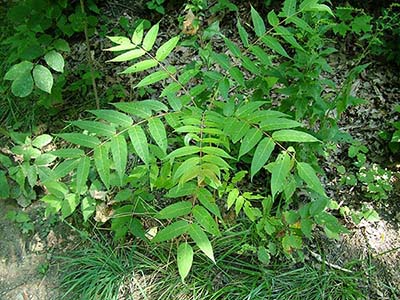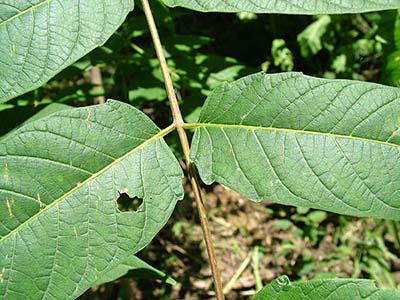 Purdue University - Extension - Forestry and Natural Resources
Purdue University - Extension - Forestry and Natural Resources
Got Nature? Blog
Invasive plant species threaten many habitats including forests across Indiana. The introduced Asian tree-of-heaven (Ailanthus altissima) is one of these aggressive and troublesome invaders. Tree-of-heaven grows very quickly on a wide variety of sites from seed and sprouts and can rapidly out-compete native trees and shrubs. There are areas in Indiana forests already dominated by this unwelcome invader. Controlling large infestations of this tree can be very expensive and even dangerous. The sap and wet sawdust of this tree can trigger an allergic reaction in some people.
There is some hope on the horizon. Research work done by the U.S. Forest Service and universities in Pennsylvania and Ohio has identified a fungus that can kill tree-of-heaven and has minimal or no impact on surrounding plants. Verticillium nonalfalfae or Ailanthus verticillium wilt is a soil fungus that has been identified so far in Pennsylvania and Ohio that can rapidly kill large patches of tree-of-heaven. Tests with this naturally occurring soil fungus have shown it to be very effective at killing tree-of-heaven without having significant impacts on surrounding native plants.
This naturally-occurring killer of tree-of-heaven could be an important tool in managing this invasive problem in Indiana. The quickest way to get started with natural bio-control of tree-of-heaven is to locate the fungus here in Indiana. Citizens and resource professionals can help us locate ailanthus verticullium wilt by identifying patches of tree-of-heaven that are being impacted by the fungus. This requires familiarity with the identification of both tree-of-heaven and the symptoms of the wilt disease on the tree.
Tree of Heaven has long, compound leaves resembling sumac or black walnut but possessing small notches or teeth at the base of the leaflets. The plant parts have a very unpleasant burnt nut odor when crushed or bruised. The bark is smooth and grey with light grey or white fissures running vertically in the bark. Twigs are very stout with a light tan spongy pith in the center.
Ailanthus wilt causes rapid death of the tree, often within one season, so look for patches of tree-of-heaven where most trees are showing wilting foliage or are already dead. The mortality will often be radiating out from a central group of dead or dying trees. Trees with wilt will have a yellow to yellow-brown discoloration of the wood directly beneath the bark. Healthy tree-of-heaven will have nearly white wood under the bark. The mortality will almost always be groups of trees, not scattered individuals. Several resources are included below to help you identify tree-of-heaven and ailanthus wilt.
If you encounter what you think is ailanthus wilt in Indiana, please contact:
Lenny Farlee, Hardwood Ecosystem Extension Specialist
Purdue Forestry and Natural Resources
Email: lfarlee@purdue.edu
Phone: 765-494-2153
Joanne Rebbeck, Plant Physiologist
USFS, Northern Research Station
Email: jrebbeck@fs.fed.us
Phone: 740-368-0054
Resources
Ailanthus Verticillium Wilt Photoguide, United States Department of Agriculture
Tree-of-heaven Images, Center for Invasive Species and Ecosystem Health
Scientists Using Fungi to Stop an Invader, The Columbus Dispatch
Ailanthus and Verticillium nonalfalfae Research, USDA Forest Service
Invasive Species, Purdue Extension
The Education Store, Purdue Extension Resource Center (search “invasive”)
Lenny Farlee, Hardwood Ecosystem Extension Specialist
Department of Forestry and Natural Resources, Purdue University

Recent Posts
- Farmers Helping Hellbenders RCPP Program Accepting Applications
Posted: May 1, 2024 in Aquaculture/Fish, Forestry, How To, Wildlife, Woodlands - Extension Specialist Brian MacGowan Receives Hoosier Wildlife Award
Posted: in Forestry, Wildlife - MyDNR – First positive case of chronic wasting disease in Indiana
Posted: April 29, 2024 in Alert, Disease, How To, Safety, Wildlife - Publication – Introduction to White-tailed Deer Impacts on Indiana Woodlands
Posted: April 28, 2024 in Forestry, Land Use, Plants, Publication, Wildlife, Woodlands - Publication – Understanding White-tailed Deer and Their Impact on Indiana Woodlands
Posted: in Forestry, Land Use, Plants, Publication, Wildlife, Woodlands - Publication – Monitoring White-tailed Deer and Their Impact on Indiana Woodlands
Posted: in Forestry, Land Use, Plants, Publication, Wildlife, Woodlands - Publication – Managing White-tailed Deer Impacts on Indiana Woodlands
Posted: in Forestry, Land Use, Plants, Publication, Wildlife, Woodlands - Report Spotted Lanternfly – Purdue Landscape Report
Posted: April 10, 2024 in Alert, Forestry, Invasive Insects, Plants, Wildlife, Woodlands - Declining Pines of the White Variety – Purdue Landscape Report
Posted: in Alert, Disease, Forestry, Plants, Wildlife, Woodlands - Are you seeing nests of our state endangered swan? – Wild Bulletin
Posted: April 9, 2024 in Alert, Forestry, How To, Wildlife
Archives
Categories
- Alert
- Aquaculture/Fish
- Aquatic/Aquaculture Resources
- Ask the Expert
- Christmas Trees
- Community Development
- Disease
- Drought
- Forestry
- Forests and Street Trees
- Gardening
- Got Nature for Kids
- Great Lakes
- How To
- Invasive Animal Species
- Invasive Insects
- Invasive Plant Species
- Land Use
- Natural Resource Planning
- Nature of Teaching
- Plants
- Podcasts
- Ponds
- Publication
- Safety
- Timber Marketing
- Uncategorized
- Urban Forestry
- Webinar
- Wildlife
- Wood Products/Manufacturing
- Woodland Management Moment
- Woodlands

